#wheelchair user characters
Text
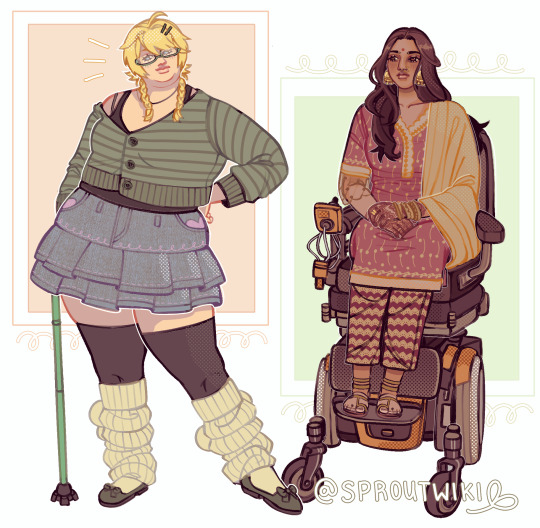
[Description ID in alt-text]
I’ve had really bad art block … + I’ve been super ill 😞❤️
#my art#art#disabled artist#original characters#wheelchair user#powerchair#motorized wheelchair#cane user#cane#image id in alt text#babe with a mobility aid#disabled and cute
2K notes
·
View notes
Text
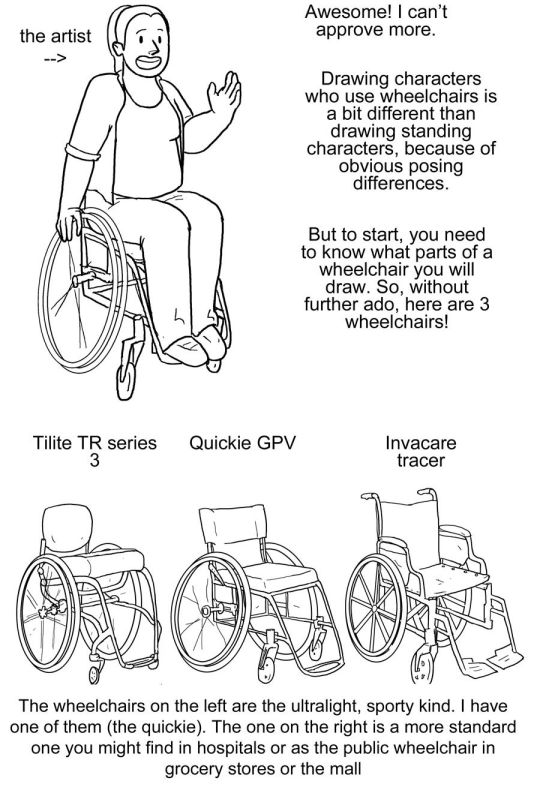
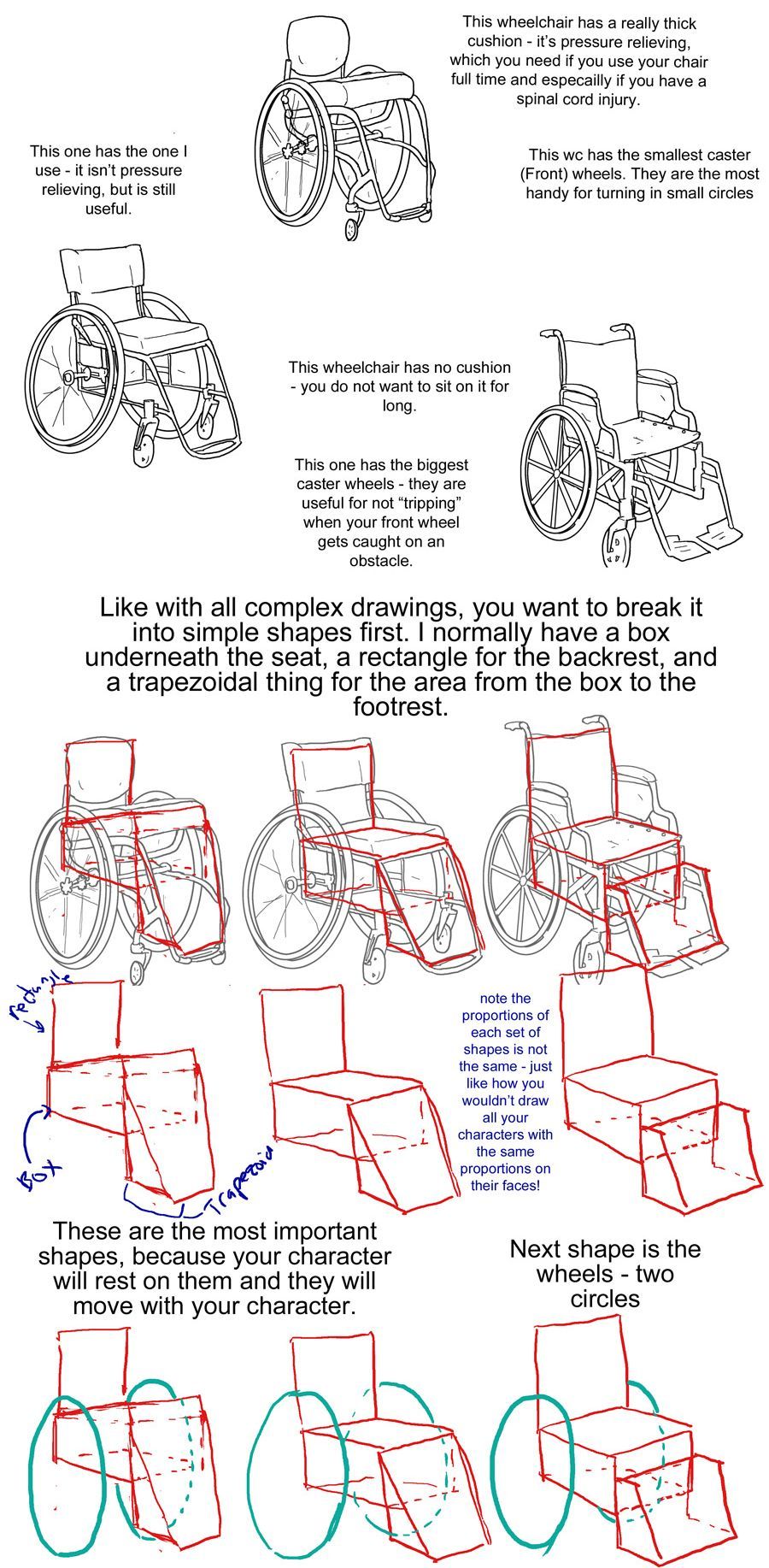
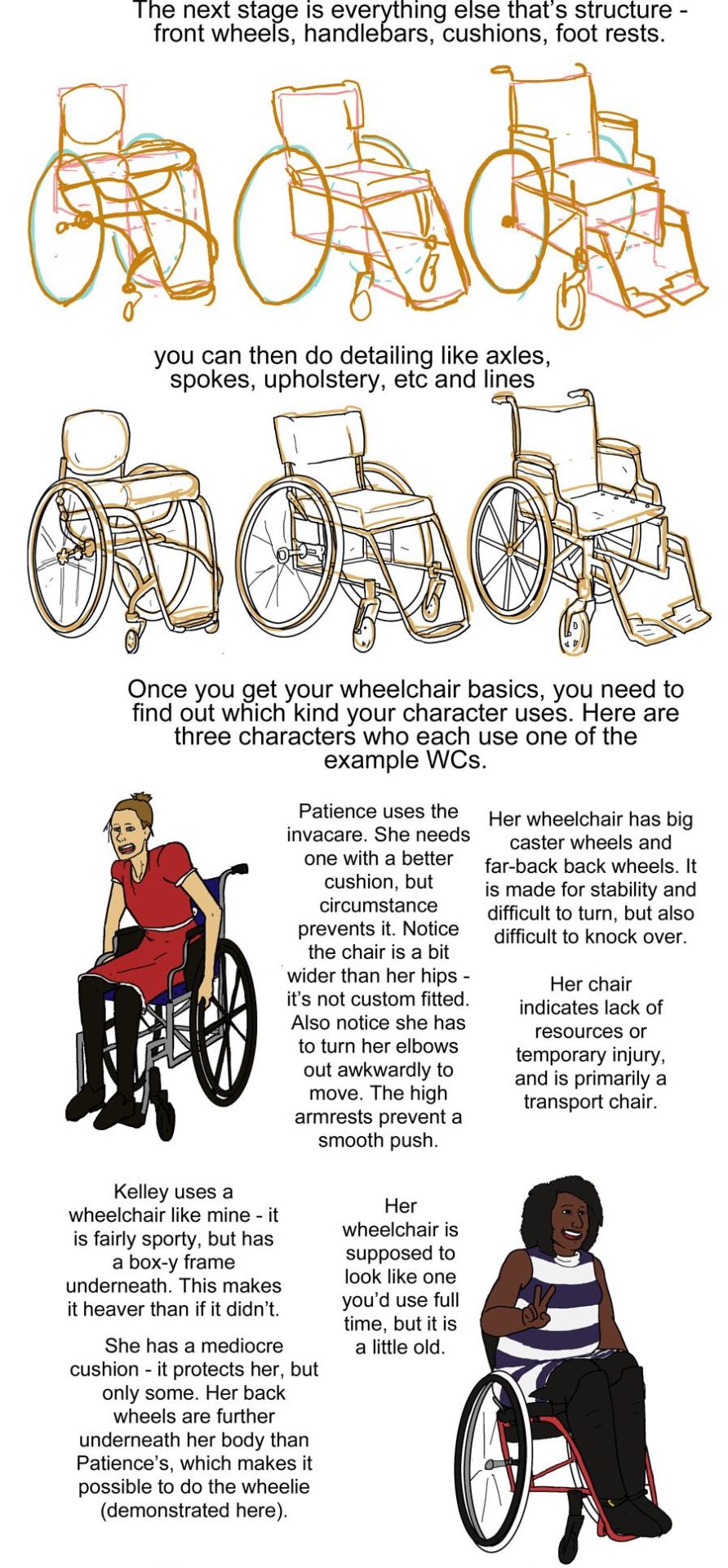
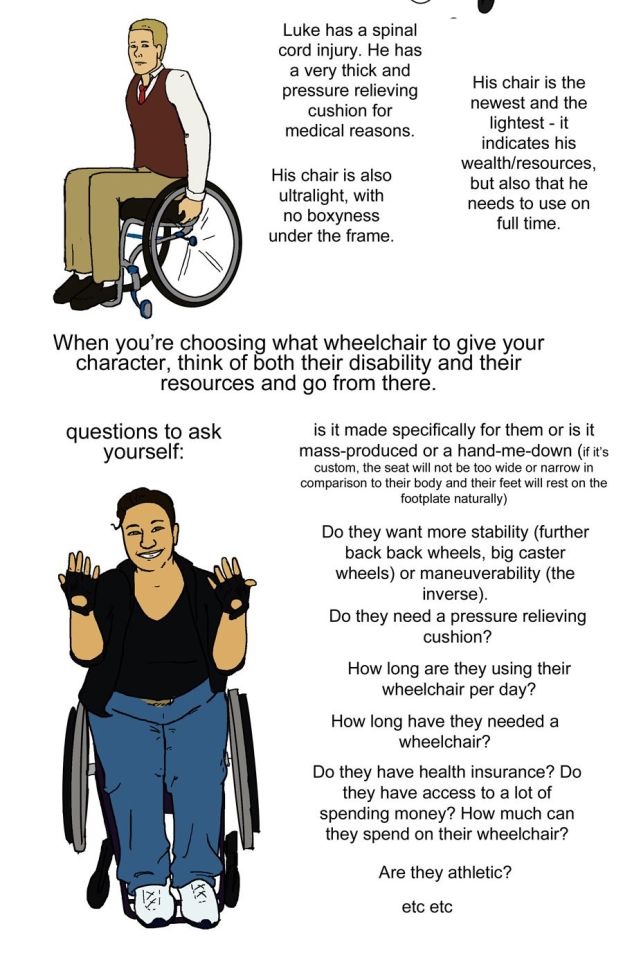
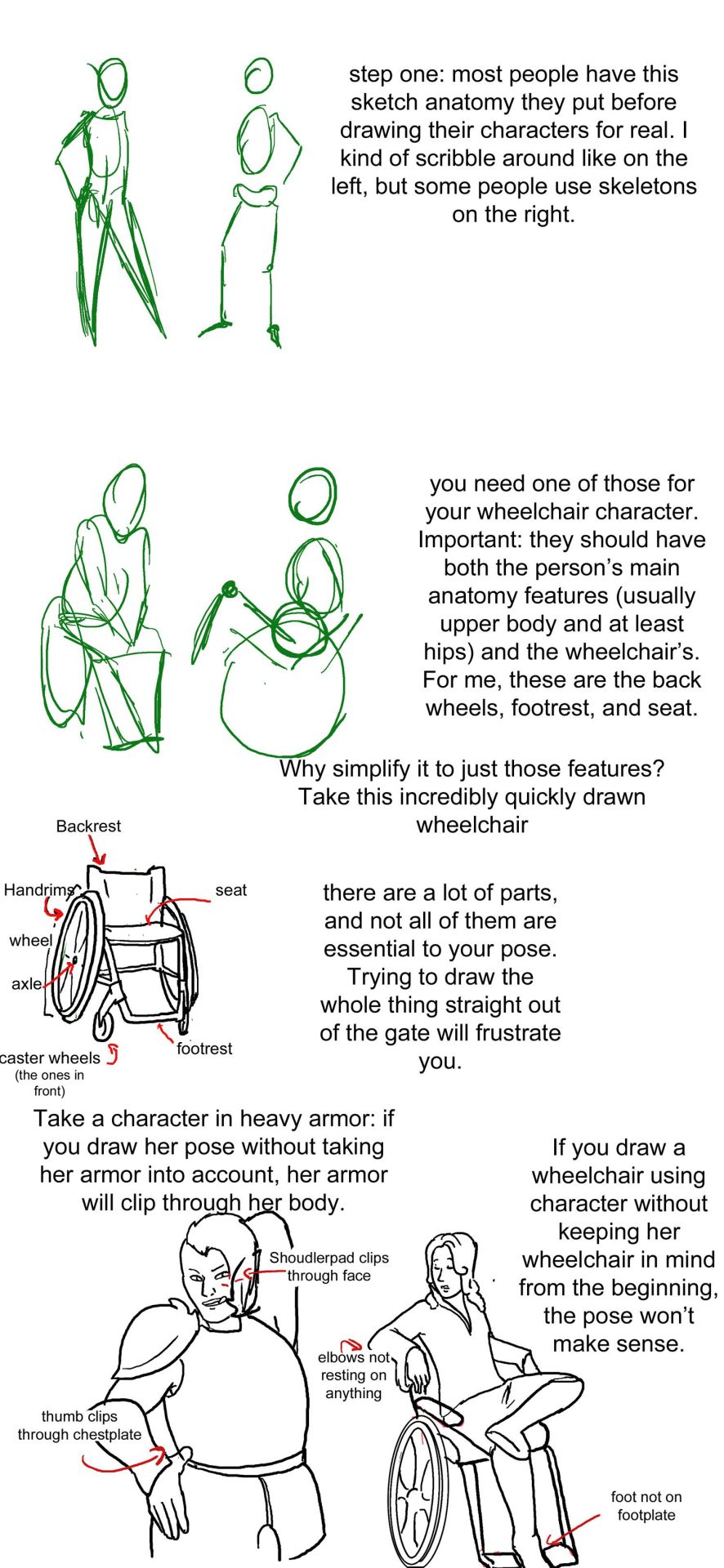
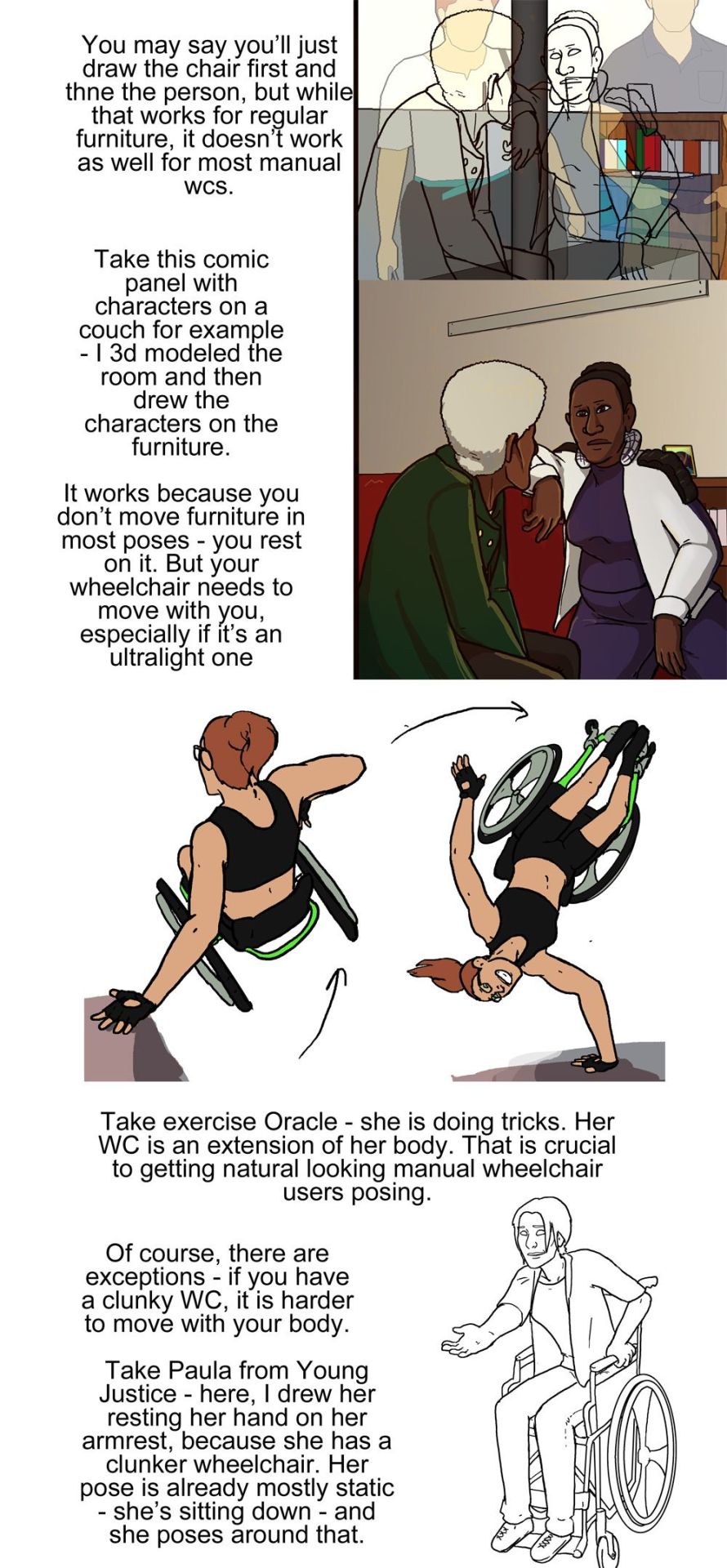
Manual Wheelchair Tutorial by Fade31415
So... I technically drew this 3 years ago but forgot to post it. I think I was going to clean up the end and make a nice recap, but I ran out of steam and then just left it as a wip for years. I got reminded of it because I was talking to a friend about how to draw wheelchairs today.
This covers most of what I view as the most common errors when it comes to drawing characters who use manual wheelchairs. I hope it helps you a lot.
Image description is in alt text, but there is a back up image description under the cut in case that does not work for some reason
[image description: a 4 picture long wheelchair tutorial. the background is white and the text, when it appears, is black and in calibri. each step will be labeled with "Step #" and a description of the drawing next to it, and "text" and then the text that is written to explain it to follow.
Step one text: So, you want to draw a character who uses a manual wheelchair? Awesome! I can't approve more. Drawing characters who use wheelchairs is a bit different than drawing standing characters, because of obvious posing differences. But to start, you need to know what parts of a wheelchair you will draw. So, without further ado, here are 3 wheelchairs!
Step one image: a simplified drawing of a chubby woman sitting in a quickie GPV manual wheelchair and resting her hand on the handrim of one of the wheels. this is labeled "the artist"
step two: next there is a lineart drawing of three wheelchairs. one is a tilite TR series 3. this is an ultralight wheelchair with a bucket seat (the back is lower than the front), a big cushion and a short backrest that kind of contours to the back of the person who would sit in it. the caster wheels (front wheels) are very small and the footrest is just two little metal bars. next image is a quickie GPV. this is also an ultralight wheelchair with a low back, but its caster wheels are slightly larger, the back has regular upholstery (it does not look like it was made to conform to the back of the person who sits there) and the frame is boxier -- there is no bar underneath the seat where the wheels would attach, rather each wheel is attached to the side of the chair. the next wheelchair is an invacare tracer. it is how most people imagine wheelchairs when they hear 'wheelchair'. it has no cushion and it has a high backrest with handles. it has high armrests that would be comfortable to rest your elbows on if you were just sitting. the wheels are not bicycle wheels like the previous two but are rather plastic. it has big footrests and big caster wheels.
text: the wheelchairs on the left are the ultralight, sporty kind. I have one of them (the quickie). the one on the right is a more standard one you might find in hospitals or as the public wheelchair in grocery stores or the mall.
step three: first is text to accompany the tilite. "This wheelchair has a really thick cushion - it's pressure relieving, which you need if you use your chair ufll tiem and especially if you have a spinal cord injury. This wc has the smallest caster (front) wheels. They are hte most handy for turning in small circles." next there is text to accompany the quickie gpv: "This one has the one I use -- it isn't pressure relieving, but is still useful." next is text to accompany the invacare: "this wheelchair has no cushion - you do not want to sit on it for long. This one has the biggest caster wheels - they are useful for not 'tripping' when your front wheel gets caught on an obstacle.”
step four text: like with all complex drawings, you want to break it into simple shapes first. I normally have a box underneath the seat, a rectangle for the backrest, and a trapezoidal thing for hte area from the box to the footrest. these are the most important shapes, because your character will rest on them and they will move with your character.
step four image: the lineart of each wheelchair has been put on reduced opacity, so we can see the square representing the backrest of each seat (the square is the smallest for the tilite and biggest for the invacare), the box for each seat and area underneath it, and the trapezoid for the footrests. the next step labels the images of these simplified shapes as the lineart is removed. "Note the proportions of each set of shapes is not the same - just like how you wouldn't draw all your characters with the same proportions on their faces!"
step 5: we see the same shapes to form the wheelchair, but now with blue circles drawn where the back wheels would be.
text: next shape is the wheels - two circles
step six: next we see the wheels and shapes have been reduced in opacity and the basic structure of everything about each wheelchair: footrests, caster wheels, upholstery details, axles has been drawn on in orange.
text: the next stage is everything else that's structure - front wheels, handlebars, cushions, footrests.
Step seven: we see the lineart on top of the lowered opacity sketch.
text: you can then do detailing like axles, spokes, upholstery, etc and lines
step eight: next we see three drawings of different characters. there is patience, a skinny white woman sitting in a blue invacare wheelchair. kelley, a slightly chubby black woman wearing a stripey dress sitting in a red quickie gpv wheelchair and doing a wheelie while smiling. then luke, a white man with short blond hair wearing khaki pants. he is sitting in a tilite chair.
text: once you get your wheelchair basics, you need to find out which kind your character uses. here are three characters who each use one of the example WCs. patience uses the invacare. she needs one with a better cushion, but circumstance prevents it. Notice the chair is a bit wider than her hips - it's not custom fitted. Also notice she has to turn her elbows out awkwardly to move. the high armrests prevent a smooth push. her wheelchair has big caster wheels and far-back back wheels. it is made for stability and difficult to turn,but also difficult to knock over. Her chair indicates a lack of resources or temporary injury, and is primarily a transport chair
kelley uses a wheelchair like mine - it is fairly sporty, but has a box-y frame underneath. this makes it heaver than if it didn't.she has a mediocre cushion - it protects her, but only some. her back wheels are further underneath her body than Patience's, which makes it possible to do the wheelie (demonstrated here). her wheelchair is supposed to look line one you'd use full time, but it is a little old.
luke has a spinal cord injury. he has a very thick pressure relieving cushion for medical reasons. his chair is also ultralight, with no boxyness under the frame. his chair is the newest and lightest - it indicates his wealth/resources, but also that he needs to use on full time.
step nine: just a drawing of me sitting in my wheelchair holding my hands up to show fingerless wheelchair gloves. we're looking at me from above.
text: when you're choosing what wheelchair to give your character, think of both their disability and their resources and go from there. questions to ask yourself: is it made specifically for them or is it mass-produced or a hand-me-down (if it's custom, the seat will not be too wide or narrow in comparison to their body and their feet will rest on the footplate naturally). do they want more stability (further back back wheels, big caster wheels) or maneuverability (the inverse). do they need a pressure relieving cushion? how long are they using their wheelchair per day? how long have they needed a wheelchair? Do they have health insurance? do they have access to a lot of spending money? How much can they spend on their wheelchair? are they athletic etc etc
posing steps:
step one: a sketch of two people standing up. one just shows the outline of a person's body, with legs that are ind of triangle shaped, the other shows a sketched pelvis and rib cage to go along with the bones of the legs and arm. text: step one: Most people have this sketch anatomy they put before drawing their characters for real. I kind of scribble around like on the left, but some people use skeletons on the right.
step two: there are now too sketched pictures of people in wheelchairs. one shows lightly traced human form (arms articulated, curve for a stomach, legs that are kind of triangle shaped and pointing down) sitting in a wheelchair that is just the sketch of footrests and wheels. the other sketch shows the sketch of a body with a circle for hips and an oval for a rib cage and the person doing a wheelie (lifting the front end of the wheelchair off the ground and leaning back). their wheelchair is also sketched out and defined by a circle for their wheels and 2 lines, 1 of the seat and 1 for the backrest. text: you need one of those for your wheelchair character. important: they should have both the person's main anatomy features (Usually upper body and at least hips) and the wheelchair's. for me, these are the back wheels, footrest, and seat. why simplify to just those features? Take a look at this incredibly quickly drawn wheelchair.
step three: there is a lineart drawing of a manual wheelchair with slightly cambered (angled towards the seat) wheels, a backrest, and a footrest. the frame is light and there are no handlebars. there are labels pointing to different parts of the wheelchair: Backrest, handrims, wheel, axle, seat, footrest, and caster wheels (the ones in front). text: there are a lot of parts, and not all of them are essential to your pose. trying to draw the whole thing straight out of the gate will frustrate you.'
step four text: take a character in heavy armor: if you draw her pose without taking her armor into account, her armor will clip through her body. if you draw a wheelchair using character without keeping her wheelchair in mind from the beginning, the pose won't make sense.
step four image: next we see two lineart drawings of different characters. one is a bulky woman wearing plate armor. her hand is on her hip and she is trying to scratch her back with the other hand. there is the label "shoudlerpad clips through face" and "thumb clips through chestplate." the next drawing shows a woman in a wheelchair with one foot rested on her knee and her arms rested back, such that they would be rested on the back of a regular chair, but the back of her wheelchair is not wide enough for them to actually be resting on anything. the text here reads "elbows not resting on anything" and "foot not on footplate"
step five: there are two images, one is lineart on top of a 3d modelled apartment with sketchup, the other is a colored in version of that lineart with the background also colored in and no longer a 3d modelled screencap two characters, one old woman wearing a green jacket and one younger woman wearing a white shirt and blue undershirt, are sitting on a couch. the old woman is leaning forward and the young woman is resting her arm on the couch. behind the young woman is a bookshelf.
step five text: you may say you'll just draw the chair first and then the person, but while that works for regular furniture, it doesn't work as well for most manual wcs. take this comic panel with characters on a couch for example - I 3d modeled the room and then drew the characters on the furniture. it works because you don't move furniture in most poses - you rest on it. but your wheelchair needs to move with you, especially if it's an ultralight one.
step six image: there is a flat color drawing of barbara gordon in her wheelchair. she is wearing a black sportsbra and black shorts. in the first image we see she is doing tricks in her chair, zooming through the air (as if she has just launched herself off the ground in a skater park or somethign) while her left hand is resting on a structure and her right hand is heading towards the right handrim. the next image shows her right hand planted on the ground and her chair and body above her, such that she is briefly doing a one-handed handstand, but the motion line indicates that she is moving and this will not last. her left arm is near the handrim of her left wheel.
text: take exercise Oracle - she is doing tricks. Her WC is an extension of her body. That is crucial to getting natural looking manual wheelchair users after posing.
step seven: we see a lineart drawing of paula from young justice. she is sitting in a standard manual wheelchair with high armrests (goes up to the bottom of her ribs probably) and a high backrest (goes up to just below her shoulderblades). she is setting her hand on the armrest, leaning forward, and holding her other hand out.
text: of course, there are exceptions - if you have a clunky WC, it is harder to move with your body. Take Paula from young Justice - here, i drew her resting her hand on her armrest, because she has a clunker wheelchair. her pose is already mostly static - she's sitting down - and she poses around that.
#wheelchair#wheelchair user#manual wheelchair#wheelchair tutorial#tutorial#drawing tutorial#my art#disabled characters
50K notes
·
View notes
Text
Tips for writing and drawing Wheelchair using characters: Your character's wheelchair can tell us a lot about them
When you first start learning character design, you'll often be told something to the effect of "use your character's outfit to tell us more about them" - and this same principles can be applied to a disabled character's mobility aids.
Mobility aids like wheelchairs, to many disabled people, are a part of us. They can be an extension to a person's body and chances are, if you're going to be using this piece of equipment every day for the foreseeable future (or at least for a good amount of time for the foreseeable future), it's going to start reflecting some aspects of your personality, your interests, your passions, especially when you remember, a lot of people get their wheelchairs custom built for them.
You can use your character's wheelchair to tell us a lot about them without ever needing to show/describe them directly.
Let me show you two examples:

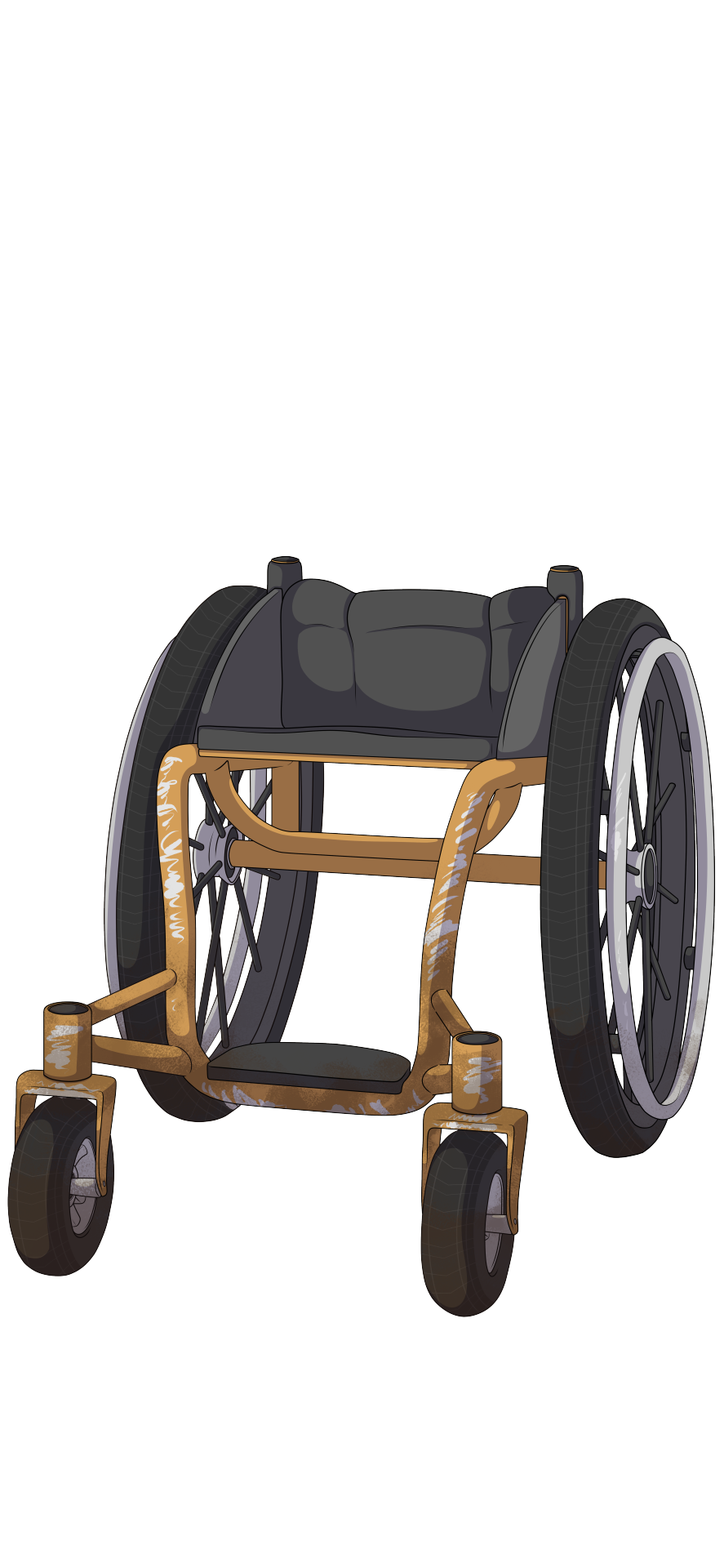
Take a look at these two wheelchairs. they're similar in shape and build, but still pretty different to each other. Can you make some guesses about their users based only on what's shown here?
intended answers below:
Please note, the following points are all generalisations and the real world is rarely this simple. This is to demonstrate how to use disability aids to contribute to your character's design, not how to make assumptions about real people in real life.
So here are some similarities between the chairs:
Both wheelchairs have ridged frames, this means the wheelchair can't be folded in any way. These kinds of chairs can imply a few different things depending on the person. They are typically lighter, sturdier and more durable, and indicate the person probably will be using the wheelchair for a long time and/or has the money to get something built to last (or lives in a place where cost not an issue due to universal/subsidised access to healthcare). They are also typically better to travel with when flying, as they are less likely to be broken by airport security/staff.
Both wheelchairs also lack anti-tip wheels, which are a third set of wheels that extend from the back of the chair. Them not being present could indicate the person is likely pretty confident in their ability to use the chair without worrying about tipping out. It could also indicate they are in an environment where the anti-tips could be more of a hazard than a help, such as on rough terrain.
So lets look at some specifics for the green wheelchair:
Take a look at the wheels. The front wheels are pretty small and appear to be solid, while the back wheels appear to be quite narrow (compared to the orange chair anyway). This indicates the user likely lives somewhere with decent accessibility like a (well funded) city where they are unlikely to encounter unpaved/dirt roads/grass. Small front wheels and thin back wheels are good for manoeuvrability and a smooth ride over even terrain, but they will get stuck as soon as bumps appear, so this probably isn't an issue for this person.
While its a bit hard to tell unless you have seen other similar wheelchairs, this wheelchair is very long in the front, meaning the footplate and front wheels are further away from the seat than most. There could be a few reasons for this. One either indicates the person has very long legs, or a lack of motion in their knees, making it harder to bend their legs. This is moves the chair's centre of gravity forward by a decent amount, making it harder to tip back, which could indicate the person's legs are very light. You tend to see this most often in the wheelchairs of bilateral leg amputees, who are at a greater risk of tipping backwards due to a lack of weight at the front of the chair (even if they wear their prosthetics).
The colour of the chair is bright. This could simply be the character's favourite colour, or maybe this colour has some significance to them?
There are stickers on the side of the chair relating to the Paralympics. This could indicate the person is a fan, or perhaps had some involvement in the games?
The wheelchair has handles on the back, but they are able to be folded down. This is a popular feature for people who are independent enough to go out on their own, but still want to have the option for some help. folding down the handles also deters random strangers from grabbing at you (an unfortunately common experience for wheelchair users).
There is some mild paint scratching to the front of the wheelchair, but nothing too noticable. This is typical of older chairs and people who are a little rough on their chairs. Maybe they've had a few stacks and falls throughout the years, probably going a decent speed.
Ok, now let's look at the orange chair
This wheelchair has very large, inflatable front wheels, and very thick back wheels. This will make the chair slower and less manoeuvrable on flat/even surfaces, but much, much easier to push on rough terrain. This is supported by the amount of mud on the wheelchair.
The seat on this wheelchair tilts upwards slightly. This is called a bucket (or according to an old basketball teammate of mine, a dump-truck lol). This is a feature you typically see in wheelchairs made for people with spinal injuries who are unable to move their legs and engage their lower bodies or core to help keep them stable.
The back of this chair is very low, indicating that if this wheelchair user has a spinal injury, it's probably pretty low on their spine, likely fairly close to the hips, making the person a low-level paraplegic. Higher-level paraplegics and quadriplegics usually need a higher back to help support them and keep them from flopping over, since all the muscles below their place where their spine broke either doesn't work, or is significantly weaker. Higher backs though can get in the way of pushing and reduce mobility, so people who need less support will likely opt for a lower back rest.
This wheelchair has no handles, which indicates the user is probably very independent and doesn't need a lot of help getting around.
The paint on this wheelchair is very scratched up, showing the person is very tough on their wheelchair and doesn't care to get the paint touched up.
This wheelchair has no breaks. This is very common on chairs with larger tiers as they don't tend to be as effective, but also on many outdoor wheelchairs, for two reasons. One is because they are made for rough terrain, so chances are, you aren't going to go far without a big push to get you moving. The second reason is that to get over large bumps and obsticals in a wheelchair, it can be helpful to do very large pushes using the top and front of the wheel. When pushing a normal chair, most people will only use the top section of the wheel to push since it's closest, but these big pushes that use the front of the wheel make it easier to push, since you can benefit from downwards momentum. However, this is also where the breaks are located on most wheelchairs, which can create a hazard. I've lost entire fingernails by them getting snagged on the breaks when pushing this way. So if you live somewhere where the breaks are not going to be helpful to you often, it makes sense to not get them.
And here are the characters who own these wheelchairs
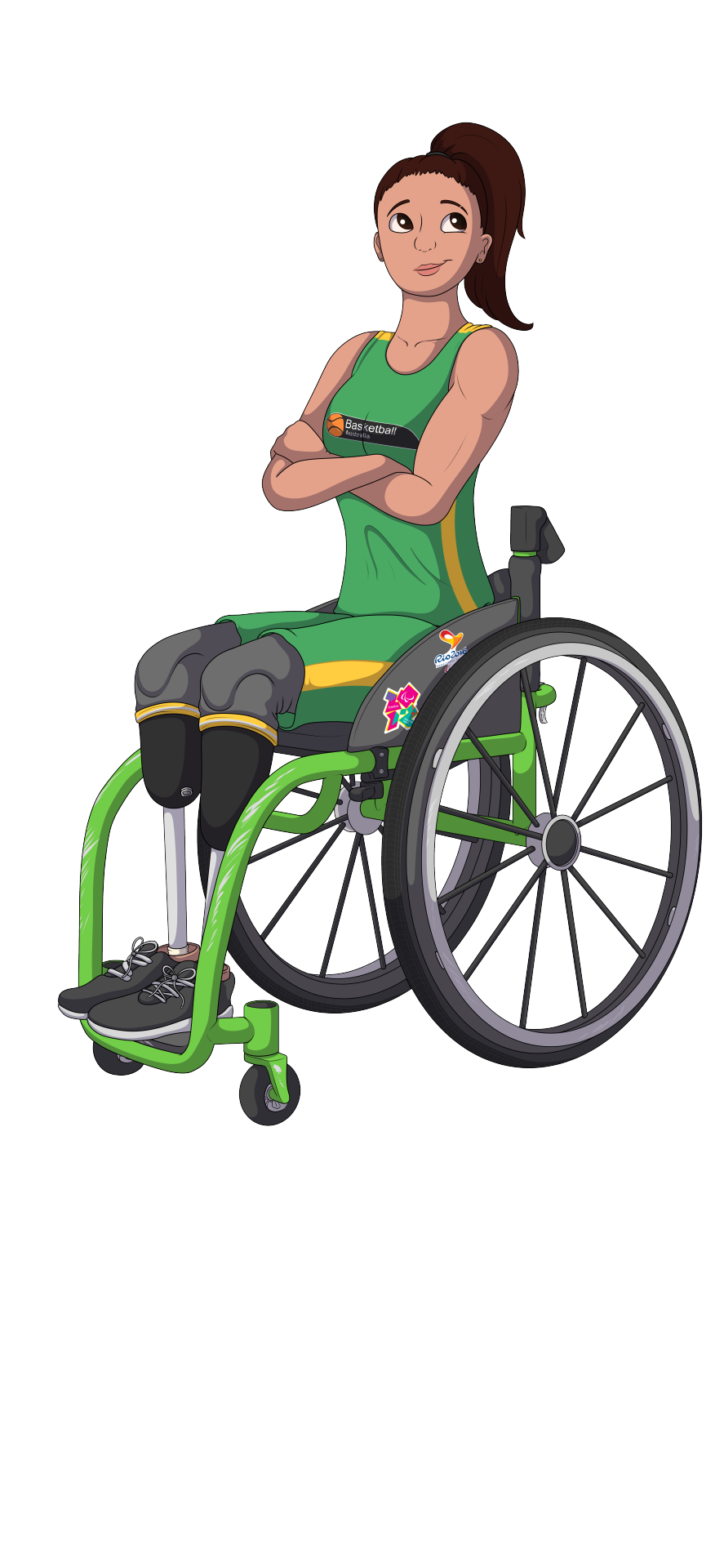
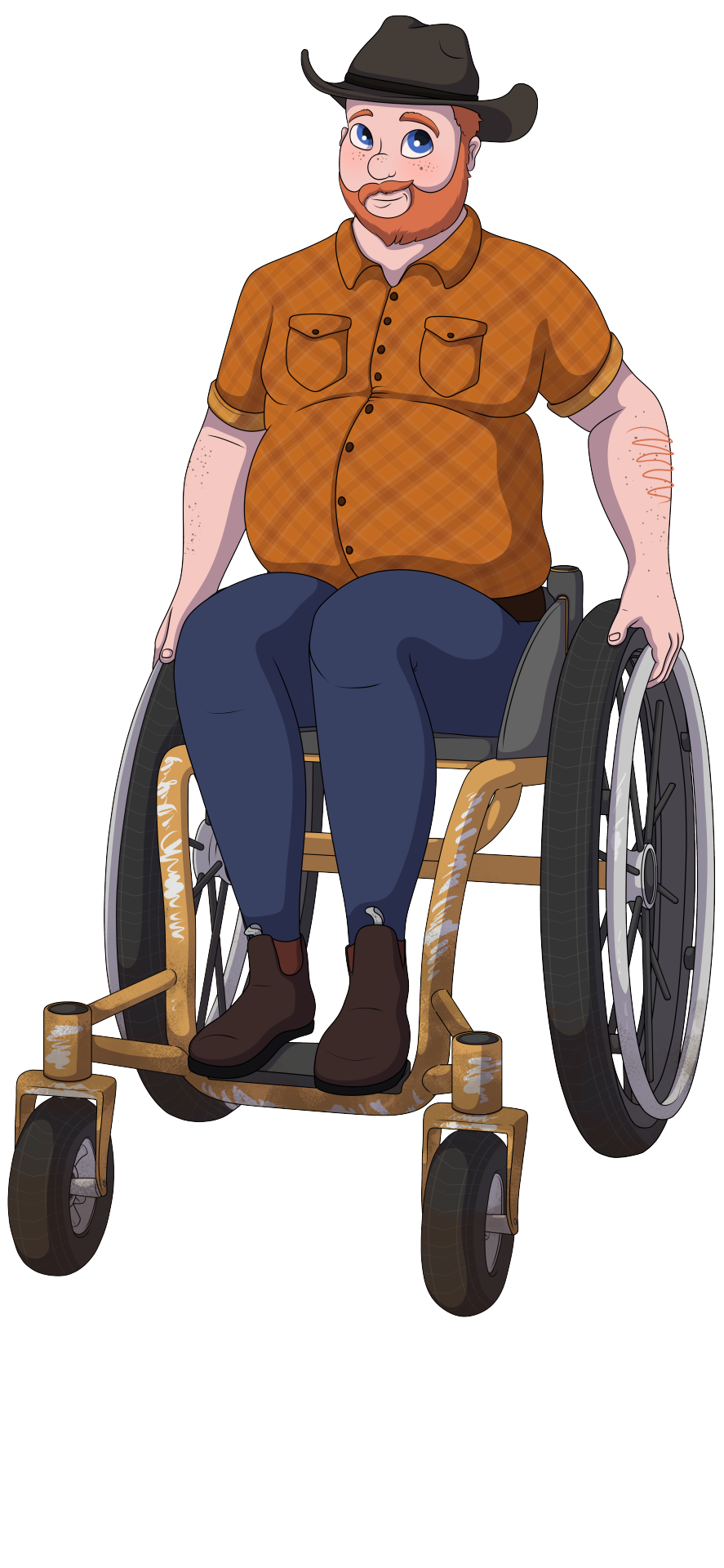
The owner of the green wheelchair is an amalgamation of a few people I knew from when I played wheelchair basketball. They're a bilateral leg amputee, and judging by their outfit (The Official National Wheelchair Basketball uniform for Australia), they're an elite athlete. This wheelchair is not the one they play sport in, but it still needs to be durable enough to withstand the rough treatment of airport staff when traveling, as well as heavy day-to-day use that comes with being an active person. While it needs to be rough, the person also seemed to want to prioritise speed and manoeuvrability, and likely doesn't need to worry about rough terrain too much, so they probably live in a major city.
The owner of the orange chair was inspired by a family friend of mine. They live on a farm, and need a chair that can handle life in those conditions, rough terrain and all. This comes at the cost of speed and manoeuvrability on smoother terrain, but honestly, anyone who's lived in the country knows you won't find many of those around there anyway, so that's not too big of a sacrifice. They are paraplegic, are very confident in their ability to use their wheelchair, and probably doesn't need help too often, but still benefit from some extra stability support from the raised seat on their chair.
Conclusion
Once again, these are generalisations, and in real life there are always exceptions, but I hope this helped demonstrate what I meant when I said you can use your character's wheelchair to tell us more info about them if you're smart about it.
I originally planned to do a whole series of these, showing a wider variety of wheelchairs and the people who they belong to, but I guess I kind of forgot because they've been sitting, abandoned on my hard drive for the last 2 years 😅. If that's something you folks would be interested in seeing though, let me know, I'd happily revive the series lol.
#Writing Disability with Cy Cyborg#id in alt text#long post#writing disability#disability#disabilities#disabled#physical disability#wheelchair user#physically disabled#wheelchair#character design#character illustration#character concept#Designing Disabled Characters#writers on tumblr#writing#writing community#writblr#writerblr#writing advice#writing tips#writing resources#art reference#artists on tumblr#artblr#illustrator#visibly disabled#disabled and proud
4K notes
·
View notes
Text
no I don't think some people get it.
Barbara Gordon should not ever be Batgirl ever again. She is an adult woman, who has grown fr past the role. Who lost her ability to walk. Who lost a good chunk of her mobility, and had adjust to disability. If you've ever lost a bodily function you've had your entire life it drains on you both mentally, and physically. Having to fight with yourself to adjust to a new reality to learn to adapt to the world your now living in. It is a fucking battle, and the world is not made for you in the end.
She had to get used to slighting lopsided sidewalks are, two floor buildings without elevators, trying to wheel over carpet, not being able to do things she's always done, etc. And in the end she ended up becoming more powerful than ever before as Oracle. So the goddamn fucking audacity to take her back to Batgirl.
#Written by a chronically ill wheelchair user#This doesn't cover all of it#Just had to get sind if it out.#Before the thought left my head#batgirl barbara gordon#barbara gordon oracle#barbara gordon#oracle barbara gordon#batmen#batfam#batfamily#batman#dc comics#batgirl#batman and robin#bats#dc characters#dccomics#dc#wheelchair user#wheelchair#mobility issues#mobility assistance#disability#disabilities#disabled characters#actually disabled#disabled
3K notes
·
View notes
Text
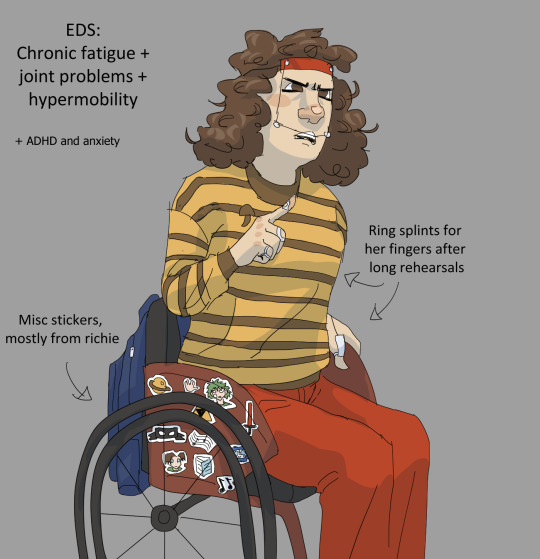
My headcanons for Ruth! I put her in a wheelchair cuz she deserves it <3
#hatchetfield#ruth fleming#hatchetverse#starkid#nerdy prudes must die#my art#disability headcanon#wheelchair user headcanon#give all ur characters mobility aids do it now#starkid fanart
625 notes
·
View notes
Text

Disabled Furs Rock!
#gurokinart#art#alt art#alternative art#furry#furry art#creepy cute#emo#emocore#feral art#disabled#disabled characters#disabled artist#traditional art#marker art#slap stickers#scene#scenecore#wheelchair#wheelchair user
1K notes
·
View notes
Text

Without the Eye, he's got a shit ton of injuries that healed badly and chronic pain
#first time drawing a wheelchair and I'll need some more practice like what do you mean the other side behind his legs exists?#the magnus archives#tma fanart#jonathan sims#disabled character#disabled jonathan sims#wheelchair user jonathan sims#jonathan sims fanart#my art#the admiral#jonathan sims and the admiral#cat
263 notes
·
View notes
Text


[id: drawing of wheelchair, one colored one line art. functionally described below. end id]
wheelchair design for original character n frame ended up being way too complicated n it going make me not want draw them much idk why did that
character is high support needs developmental disability n so typical style low back rest ultralight not enough hence chair is Not Like That. is in fantasy magical setting n magic bring some accessibility, n weight is non issue part because of that part because even most boring wheelchair w high back rest n headrest n etc going be heavy as fuck so some extra weight from decoration really not going matter.
frame is golden & swirly n decorated like those antique european royal chair/couches thingie
good ol big wheel forget draw push rim pretend it there
seat n back itself also in style of those antique royal chairs but in light blue. is tilted & has dump. has headrest n same color
have stroller style push handles bc those easier push for caregiver with one hand if they doing something on the other hand
have angel wing attached to back to seat that is power assist. controlled by angel halo like joystick & is right where usual right handed joystick is, tho can be removed n wear like bracelet n control movement that way for more dynamic flow
idea is can tilt in space can recline can elevate like CRT powerchairs despite manual chair style bc like look & hybrid better… still thinking about specifics of how do that but again magical setting most likely going be frame metal shifting n swirly swirl help w that
reblog ok but don’t repost without permission
#art#wheelchair#wheelchair user#artists on tumblr#digital art#digital illustration#mobility aid#loaf screm#🍞.txt#oc#original character
125 notes
·
View notes
Text
very glad that they've removed the curse from lydia but i really hope this doesn't mean she's just magically totally healed and no longer disabled because that. sucks as a trope
#like there arent that many physically disabled characters in fantasy high and it would just. suck kinda#if they went 'and now by magic the wheelchair user no longer needs a wheelchair!'#like thats such a tired ableist trope yknow#idk i just. i have a lot of feelings about physically disabled characters and i hope they treat lydia right#my post#d20#fantasy high#fhjy
91 notes
·
View notes
Text
disabled regina george doesn’t give a shit about gossip. she’s confident in who she is, and doesn’t need to be mean anymore to assert it. running north shore high isn’t even on her priority list anymore, but her presence is impossible to ignore. the leather jackets, the pink cane and wheelchair, the platform boots, she’s a force to be reckoned with and she knows it.
she has limited energy and only spends it on what she wants and if you cross that boundary, you’ll get bitten. she has zero patience for clothing stores who use their accessible changing rooms as storage spaces. she gets pissed if people call her inspirational and won’t hold back if someone is being ableist, even if they’re a teacher.

#regina george#mean girls#disabled regina george#POTS#spinal injury#disability#mean girls 2024#renee rapp#disabled character#headcanon#disabled headcanon#chronic illness#ambulatory wheelchair user
118 notes
·
View notes
Text
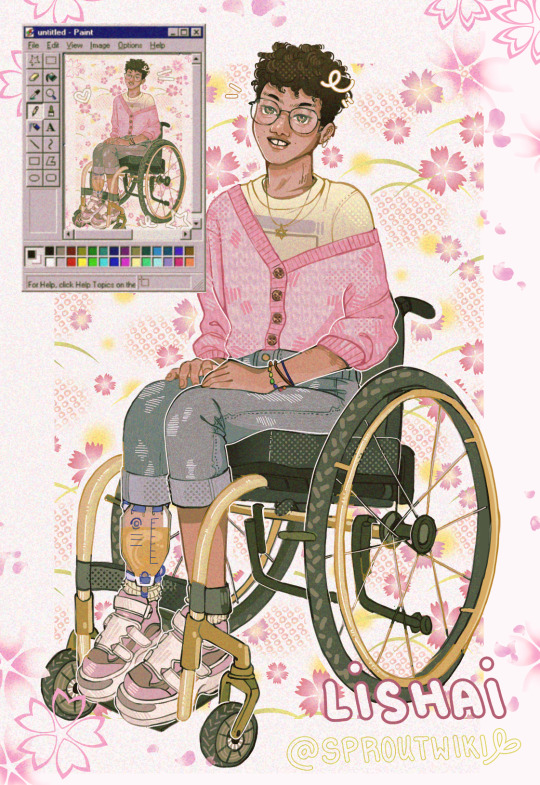
Lishai 🌈🌸♿️🩷🪴 [ID in alt-text]
He has PPMS and uses an intermittent catheter! There is way too much stigma (from both disabled and non-disabled people) about incontinence, catheters, and bladder issues. It’s not “gross”. The only “gross” thing is being judgmental of disabled people for something they cannot control and keeps them alive.
#my art#art#original characters#disabled artist#disabled characters#disabled oc#wheelchair user#catheter#ms#multiple sclerosis#illust#illustration#babe with a mobility aid#disabled and cute#wheelchair
3K notes
·
View notes
Text
Writing Wheelchair Users
Hello hello hello it’s another Disability Writing Guide from me! As always, this is a general guide gleaned from my personal experience of working with, taking classes on, researching, and having friends in disabled communities. This is writing advice, not a primer on disability justice (although I’m always happy to talk about disability justice).
Okay. Disclaimer over. Onto the writing advice.
Different Types of Wheelchairs
Before you write a character that uses a wheelchair, you need to know why they need the chair. Different disabilities mean different types of chairs. Some questions to get you thinking -
Manual chairs: Are they temporarily disabled, or is this long-term? Is the chair for indoor and outdoor use? What different types of terrain will the chair need to navigate? Is the person active and able to move themselves, or would someone else be pushing the chair? What kind of postural support does this person need? Can they transfer themselves in and out of the chair?
This guide is helpful for figuring out some of the options that are available and why a person might need them. Please do the research to ensure the type of chair you pick makes sense for the disability you’re writing about. Do not pick a chair based on aesthetics, or avoid a chair because some of the functions seem complicated.
Power wheelchairs: Many of the same questions apply about posture, indoor/outdoor use, and types of terrain. Ability to move oneself does not apply, nor does temporary disability or transferring ability.
How is the chair steered? If someone doesn’t have strong fingers, joysticks can be ultra sensitive. I’ve seen a chair that someone steered with her head, and have heard of chairs that are steered by tongues. Just because someone has very limited mobility doesn’t mean they can’t be independently mobile to some extent.
If the character does a lot of work with their hands, it may make sense for the chair to have a tray for them to work on. This is more common in power chairs than in manual chairs.
Not a question, but power wheelchairs generally have a top speed between 5-10 mph, with the average on the lower end of that scale. Sometimes they can be made to go faster, but that’s generally not useful for the person using the chair, and can damage the chair itself. Before you make your character’s wheelchair insanely powerful and fast, please think about if that makes sense for your setting, your character, and their disability. It’s fun, but it’s pretty unrealistic, and wheelchair users hear enough jokes about them “running people over.”
I know there are fancy wheelchairs out there that like, go up and down stairs. These are unreasonably expensive and never really work the way they say they do. If you want your character to be realistic, be extremely cautious about them having the latest and greatest mobility tech.
All wheelchairs are expensive. That being said, power wheelchairs are much more expensive. The more features it has, the newer it is, and the more customized to a person’s needs, the more expensive it will be.
Wheelchair Etiquette
I think I get a lot more disability stuff on my social media because I talk and think and read about it more, so I’m going to start with the very basics. I apologize if it’s repetitive or I’m being unnecessarily detailed!
Do not lean on a person’s chair. Do not have other characters lean on a character’s chair. If they are close friends, maybe, but generally speaking, a wheelchair should be treated as an extension of someone’s body - because it is. So no leaning, sitting on, or pushing it without being explicitly asked.
Also, of course, people who use wheelchairs have fun just like everyone else. Some people do let others ride on the backs of their chairs, or try stupid things just to see what happens. A character’s willingness to do this should be consistent with their personality, and the fact that their chair is likely a very expensive and medically necessary piece of mobility equipment.
Do not use a wheelchair outside its intended purpose. See the above points - it’s an extension of someone’s body, it’s expensive, and it represents someone’s mobility and independence. Shouldn’t be used for moving things or other people. Again, there can be exceptions to this.
Do not refer to someone by their mobility aid. Some people are fine being referred to as wheelchair users. Others prefer “person who uses a wheelchair.” Do not ever call someone “wheelchair guy,” “wheelchair woman,” or “wheelchair person.” A wheelchair is something you use. It is not what you are.
People customize their wheelchairs in a lot of ways. Obvious ways are stickers, colors, ribbons, etc, but customization can also be a tote bag with necessities hanging off the back, a particular cushion, or blanket.
Do not move someone else’s wheelchair without their permission. Firstly, no one should even touch a wheelchair without permission. Secondly, moving a wheelchair means its owner may not be able to find it or transfer into it when the time comes. Last, many people don’t like to be separated from their chair, or to have it leave their sight. It’s an extension of their body. They don’t want it disappearing somewhere they can’t follow.
Treat wheelchairs with care. This underlies everything I’ve written, but it’s worth saying explicitly. In my opinion, it would be unrealistic to have a wheelchair user and/or their friends be careless or reckless with their mobility equipment. Once again - it is expensive, it is their mobility, and it can take a long time to replace or fix.
This ties into the above point, but not all wheelchairs are created equal. They are not interchangeable. Their functions are usually tailored as much as possible to the person that uses them, and that makes a big difference in someone’s comfort, mobility, and independence.
Do not talk down to wheelchair users. This has several meanings. The first is to not be condescending, ever. The second is that some wheelchair users prefer that able-bodied people crouch or sit to speak to them, so they’re at a more equivalent level. Others find this condescending, so proceed with caution and when in doubt, ask. Do not bend over to speak to someone, or tower over them, forcing them to crane their neck. Both of these are always considered poor form.
Wheelchair users do not need, and often do not want, to share their diagnoses. If this character is a major part of your story, their diagnosis and its particulars will affect much of what they do, so please have a specific diagnosis in mind. If they’re a smaller character, or speaking to another character, they may not discuss the particulars of their life or diagnosis, and that’s okay. No one needs to explain their disability, visible or invisible.
Do not use the word cr*pple. Some wheelchair users may use it to describe themselves, especially to other disabled people. As an abled person myself, I would not presume to use that word and I would recommend others do not either.
People are not “wheelchair bound” or “confined to a wheelchair.” People tend to really appreciate the freedom and increased mobility that their wheelchair provides.
Other Considerations
People who don’t have mobility in their extremities often don’t have great circulation in their extremities, either. This means people can get cold much faster than able-bodied counterparts.
People with poor circulation develop extremely sensitive feet. Feet being bumped or even just brushed can be painful.
A character may use a wheelchair and be able to walk, or may use a wheelchair and cannot walk. Either way, they can and almost certainly do still wear shoes.
People with low mobility, or anyone sitting in a wheelchair for hours at a time, need to be shifted and moved, or their weight redistributed, so they don’t develop pressure sores over places where bone is close to the skin (hips, wrists, ankles if lying down). This is non-negotiable. Your wheelchair user character will not be able to stay in the same position for six hours and be okay, no matter how padded their chair might be.
Your wheelchair user’s feet should not really be touching the ground, unless they’re in a hospital chair and it is a short-term situation. All wheelchairs come with footrests, and feet are kept elevated on a footplate. It is hard to hold your feet up continuously while moving, and there’s no real reason to do it that way.
Ableism is real, and it permeates every public, private, and internal space in the real world. If a space has stairs and no ramp, your wheelchair user character can’t enter. If the sidewalk is broken or steep, a wheelchair user may struggle to navigate. If a venue is accessible but the bathroom isn’t, a disabled character may not feel comfortable being there for long stretches of time. If your characters are going to a bar, likely it’s too high for your wheelchair using character to order. If your character uses a powerchair and is going somewhere overnight, there’d better be a place to charge their chair. Even if you’re writing in a fantasy setting, think about what it would mean for your imagined world to actually be fully accessible. If the world you’re writing in isn’t fully accessible, think about what that means for your characters, what impact it has on them, and what they have to navigate to be out in the world.
Lastly, and very importantly, make your character’s disability consistent. If your character is entirely paralyzed below the waist, you’re going to have to think about how they use the bathroom. It may not come up explicitly in your story, but it will absolutely affect the way the character behaves, where they feel comfortable going, and who with. Do not give your character zero lower body mobility and then refuse to think about bathrooming and sexual function. It is really, really disappointing to see people write disabled characters and then avoid the aspects of disability that they may find distasteful, distressing, or too difficult to think about. Okay one more time:
Many wheelchair users have sex. All wheelchair users need to use the bathroom. You don’t have to write about it, but you should think about what it looks like for your character. You’re writing a full disabled person, not an otherwise abled person whose legs don’t work. You’re also not writing a person whose entire personality is their wheelchair and thus cannot be in any kind of sexual relationship. Figure it out.
More Mobility Aids
A person with partial ability to walk may have a wheelchair and a cane, or arm crutches for when they’re able to be more mobile.
A mobility scooter is a possible alternative to a wheelchair if your character has higher mobility and transfer ability but can’t travel long distances. This is a good choice for someone who can get in and out of a wheelchair with ease and has upper body mobility with limited lower body mobility, but can’t self-propel over long distances.
A Hoyer lift is a mechanical lift used to move people with low mobility in and out of their wheelchairs. It is often unrealistic to have a person transfer someone else alone. It is almost always a two person job, and that still puts a lot of strain on the caregiver’s body.
A transfer belt is a very low cost, specially designed belt that makes transferring safer. Its primary purpose is to give caregivers something to hold onto besides a person’s body, which is safer for both parties. A transfer belt is only used when the person being transferred can stand and take at least a few steps mostly on their own.
Service dogs can be trained to open doors, retrieve items, or assist with disabilities that may not relate to the inability to walk.
Hospital beds may be used for characters with limited mobility. The heads and feet of these beds can be lifted or lowered, along with the entire bed. This aids in transferring, as well as shifting weight and position so that bedsores do not develop.
Wheelchair accessible cars or vans are great tools for independence. They’re also incredibly expensive. A van that is equipped to transport wheelchairs will have ports to anchor the chair and straps. A more sophisticated van that would allow the wheelchair user themselves to drive is usually customized to the user’s ability and needs, and even more incredibly expensive.
Caregivers I am including as mobility aid(e)s. They are trained professionals, although family members and friends can also be caregivers. Often a caregiver will be a CNA (Certified Nurse Assistant) and will be trained to help with physical needs and ADLs (Activities of Daily Living). This ranges from transferring and bathing to feeding, brushing teeth, and massage. A CNA is not able to provide any care that breaks the skin (injections, IVs), treat injuries, or dispense any medication (this includes over the counter meds). A registered nurse would be needed to perform any of these things.
Media with Wheelchair Users
I will be honest, I have a lot of memoir recommendations, but movies and TV mostly escape me. I’ll do my best! As always, I am sticking to things I personally have read or watched.
Sitting Pretty by Rebekah Taussig is a memoir by a young wheelchair user. It discusses ableism, disability, and independence.
A Body, Undone by Christina Crosby is a memoir by a queer woman who acquired a disability partway through her life. It deals with her adaptation to her life and reflects on mobility, independence, and the body.
Being Heumann by Judith Heumann is a memoir by a prominent disabled woman and activist. She tells her life story and describes the crucial work she did in working for disability rights in America.
Care Work by Leah Lakshmi Piepzna-Sanarasinha is a collection of essays by a multiply disabled, queer femme-aligned person of color. They include reflections on disability justice, disabled futures, and many aspects of disabled lives.
Demystifying Disability by Emily Landau is an all-purpose primer on many different types of disability and how to talk about them. It’s an intro to ideas surrounding disability.
Disability Visibility by Alice Wong is a collection of essays by many different disabled people about their lives and views on disability. It covers many different types of disability, and among the authors are some wheelchair users, including prominent late activist Harriet McBryde Johnson.
Spoiler alert: In the later seasons of Bones, though I don’t know exactly when, a main character acquires a disability that means he uses a wheelchair. He struggles with internalized ableism and difficult emotions surrounding disability in a limited but thoughtful portrayal.
Me Before You is bad disability representation. Both the book and the movie are bad representation. Happy to talk about this in DMs if you do not understand why. Do not use it as positive rep or research.
#disability writing guide#writing disabled characters#writing disability#disability#disability justice#writing advice#writing wheelchair users#how to write wheelchair users#wheelchair users
581 notes
·
View notes
Text
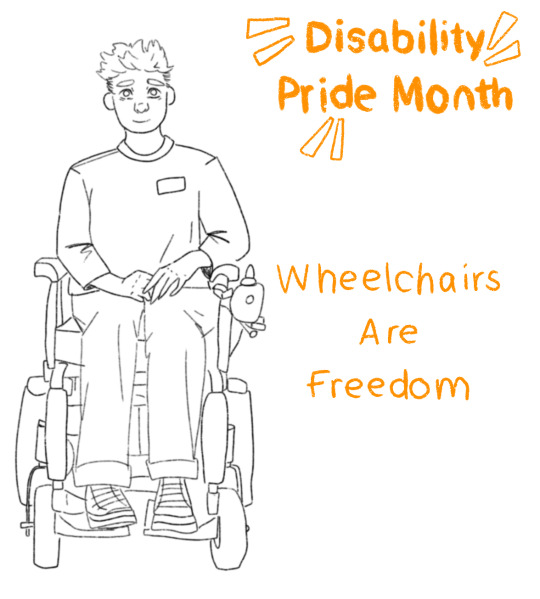
Wheelchairs are freedom, not a burden!
ID in alt
#art#original art#artist#oc art#original character#queer#disabled#disabled rights#disability#disability pride month#wheelchair#wheelchairs are freedom#wheelchair user#image description#image desc in alt text
189 notes
·
View notes
Text
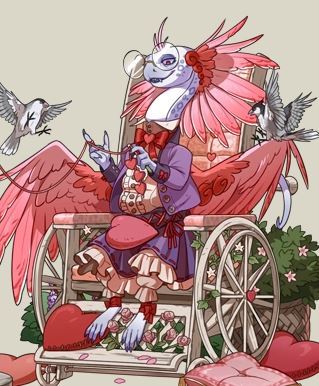
Today's disabled character of the day is Susie from Flight Rising, who is a wheelchair user
Requested by Anon
[Image Description: Drawing of an anthropomorphized white scaled dragon. She has red and pink feather wings and the same feathers on the back of her head. She is wearing a purple jacket, pink blouse, purple skirt with pink ruffles, red bow tie with a heart in the center, and glasses. She has red eyes and is knitting. She has various pillows and birds around her. Lastly she is sitting in a white wooden wheelchair with a bush and flowers behind it.]
59 notes
·
View notes
Text
so you want to draw Barbara Gordon but don't know much about wheelchairs? This is a small guide on the differences between standard wheelchairs, and a low back chair that someone with a spinal cord injury would use. I do not have a spinal cord injury but have done a lot of research into different wheelchairs due to using one. If I get anything wrong feel free to correct me.
Barbara wheelchair would be customized for comfort safety, and her daily activity. She'd most likely want a sleek design, something she can still train in. As mentioned above it will be low backed, and rather compact.

The above chair is a good example of the type she'd use. It's heavily padded to keep from developing sores. There are no real armrests as those can get in the way. The caster wheels (the small ones) are there for balance. Might see silly but they are there for a reason! There's a lack of handle bars on the one above. Babs would probably pick one without them as well, so people wouldn't try to push her.
Than there are standard wheelchairs, which is what I personally have. Mine is not the same as the one in the photo, being a tad more conpacr. Many of the features make them dangerous for people with spinal cord injuries
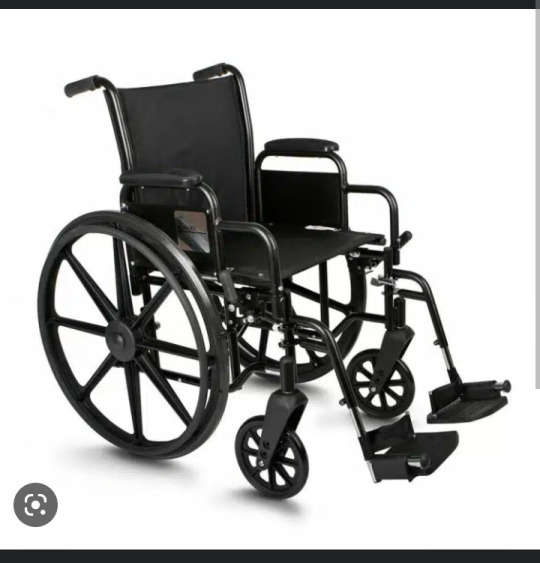
Above you can see the chair had high armrests, two piece footrest, a tall back, and no safety straps. It gives room for to much movement which could make a spinal cord injury worse. I understand that it's what most people are used to seeing. But it's not the type that Babs would be using, as it would be unsafe for her.
She'd probably also use wheelchair gloves! Which can be super cute, google them to see!
#wheelchair user#actually disabled#Chronically ill#I love Babs#So a bit of a rant#But even comic artist give her the wrong type of chair.#What a shame#No shame if you didn't know the difference though#I learned a couple years ago as my mobilty went to shit#Just if your job to draw a disabled character#In a wheelchair do research#barbara gordon#batfam#batfamily#batgirl barbara gordon#batgirl#oracle#dc comics#dc heroes#dc heroines#Dc comics#dc fanart#fuck dc comics
300 notes
·
View notes
Text
new idea: white day kanade wheelchair user
#fred’s rambles#I keep seeing one art of her where she's sitting and I keep thinking she's in a wheelchair#I also did this with wedding toya a while ago (which I still think is an absolutely amazing idea)#give me a card where a character's sitting: I will hc them as a wheelchair user#project sekai#pjsekai#kanade yoisaki
26 notes
·
View notes